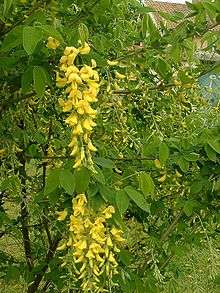laburnum
See also: Laburnum
English
Noun
laburnum (plural laburnums)
- Any tree of genus Laburnum. They have bright yellow flowers and are poisonous.
- 1891, Oscar Wilde, The Picture of Dorian Gray:
- Lord Henry Wotton could just catch the gleam of the honey-sweet and honey-coloured blossoms of a laburnum, whose tremulous branches seemed hardly able to bear the burden of a beauty so flame-like as theirs[.]
- 1950, C. S. Lewis, The Lion, the Witch and the Wardrobe, Collins, 1998, Chapter 11,
- The trees began to come fully alive. The larches and birches were covered with green, the laburnums with gold.
-
Translations
tree
|
Latin
Pronunciation
- (Classical) IPA(key): /laˈbur.num/, [ɫaˈbʊr.nũ]
Inflection
Second declension.
| Case | Singular | Plural |
|---|---|---|
| Nominative | laburnum | laburna |
| Genitive | laburnī | laburnōrum |
| Dative | laburnō | laburnīs |
| Accusative | laburnum | laburna |
| Ablative | laburnō | laburnīs |
| Vocative | laburnum | laburna |
References
- laburnum in Charlton T. Lewis and Charles Short (1879) A Latin Dictionary, Oxford: Clarendon Press
- laburnum in Gaffiot, Félix (1934) Dictionnaire Illustré Latin-Français, Hachette
This article is issued from
Wiktionary.
The text is licensed under Creative
Commons - Attribution - Sharealike.
Additional terms may apply for the media files.
